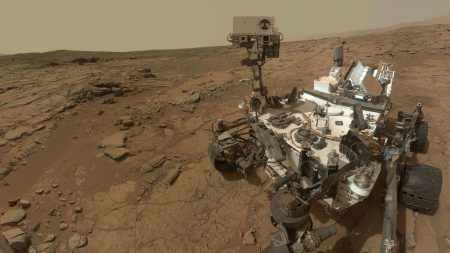NASA’s Curiosity Rover found Minerals on Mars 31/05/2019 – Posted in: Daily News – Tags: planet, solar system
NASA’S CURIOSITY ROVER FOUND MINERALS ON MARS
For: Preliminary & Mains
Topic covers: New Findings, Curiosity, Gale crater, Mars exploration Programme,
News Flash
NASA’s Curiosity Mars rover has found the highest amounts of clay minerals ever found during its mission on the Red Planet.
Two samples the rover recently drilled at rock targets called “Aberlady” and “Kilmarie” have revealed the highest amounts of clay minerals ever found during the mission.
Highlights
- Curiosity is exploring Mount Sharp to see if it had the conditions to support life billions of years ago. Clay often forms in water, which is essential for life.
- The rover’s mineralogy instrument, called CheMin (Chemistry and Mineralogy), provided the first analyses of rock samples drilled in the clay-bearing unit.
- CheMin also found very little hematite, an iron oxide mineral that was abundant just to the north, on Vera Rubin Ridge.
- It is also proved that there was a significant amount of water once in Gale Crater.
- It is likely that the rocks in the area formed as layers of mud in ancient lakes.
- Something Curios is also found lower on Mount Sharp.
Gale crater
Gale Crater is a fascinating place to explore because of the mountain of layered materials in the middle.
On Earth, this mound would be a mountain 5 kilometers (3 miles) high! The layers tell a story about what Mars was like in the past, perhaps spanning much of the history of the red planet.
NASA’s Curiosity rover
Curiosity is a car-sized rover designed to explore the crater Gale on Mars as part of NASA’s Mars Science Laboratory mission.
Curiosity was launched from Cape Canaveral on November 26, 2011 and landed on Aeolis Palus inside Gale on Mars on August 6, 2012.
Curiosity set out to answer the question: Did Mars ever have the right environmental conditions to support small life forms called microbes?
NASA’s Mars Exploration Programme
NASA’s Mars Exploration Program is a science-driven, technology-enabled study of Mars as a planetary system in order to understand:
- The formation and early evolution of Mars as a planet
- The history of geological and climate processes that have shaped Mars through time
- The potential for Mars to have hosted life (its “biological potential”)
- The future exploration of Mars by humans, and
- How Mars compares to and contrasts with Earth.
Mars
Mars is the fourth planet from the Sun and the second-smallest planet in the Solar System after Mercury. In English, Mars carries a name of the Roman god of war, and is often referred to as the “Red Planet” because the iron oxide prevalent on its surface gives it a reddish appearance.
Source: Indian Express
You can follow us on LinkedIn and for more updates related to UPSC IAS Preparation, Like our Facebook Page and subscribe our Diligent IAS Youtube Channel

